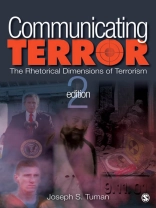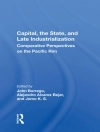The only book to examine terrorism as a rhetorical act
‘This is an excellent text in furthering our understanding of the web of language and how it creates our mediated realities – which reflect our culture, politics, religion, economics, etc. Students really like the case studies and how it complements the theory and practice of rhetoric. I think this book has applications for almost any course in communication.’
—J. Gregory Payne,
Emerson College
Concise, succinct, and provocative,
Communicating Terror, Second Edition explores multiple rhetorical dimensions of terrorism, connects terrorism to communication theories, and helps readers understand how this violence creates a public discourse for multiple target audiences.
Author Joseph S. Tuman uses fascinating case studies and examples as he explores both dissent terrorism and state terror and looks at terrorism from a communicative perspective. Presenting terrorism as a process of communication between terrorists and multiple audiences, this book examines a range of rhetorical components, including definitions and labels, symbolism in terrorism, the relationship between terror and the media, and public oratory about terrorism—by both victims of terrorism and terrorists themselves.
New to the Second Edition
- Includes three new chapters on public address and speeches concerning terrorism, symbols and targets of terror, and terrorism, rhetorical theory, and mass media.
- Offers new examples, case studies, speeches, and topic coverage, including expanded coverage of the Internet and the ‘War on Terror;’ new material on Iran, Cambodia, Rwanda, Hamas and Hezbollah, and dirty bombs
- Provides expanded treatment of rhetoric and theory with a focus on ideological criticism, neo-classical criticism, dramatism, and media-centered terrorism
- Examines diverse acts of terrorism—not just 9/11 or the recent events in the Middle East—to show the history and various usages of these acts as a medium for communication
- Includes real case studies of terrorists and terror acts that make applying rhetorical theory practical and accessible
Intended Audience
Communicating Terror, Second Edition is ideal for use in a wide range of courses, including Media & Politics, Terrorism, Media & Society, Rhetorical Theory/Analysis/Criticism, Defense and National Security, and Political Communication.
Inhoudsopgave
Introduction
1. The Struggle to Define Terrorism
Defining Terrorism
Attempts to Synthesize a Consensus Definition
Summary
Notes
2. Terrorism as a Communication Process With Rhetorical Dimensions
Terrorism as a Communication Process
Terrorism and Rhetoric
Summary
Notes
3. Labeling and Defining Terrorism as Rhetoric
Definitions and Labels
Reconsidering the Definition of Terrorism
Summary
Notes
4. Symbols, Symbolism, and Terrorism: Means and Implements
Symbols, Symbolism, and Violence/Destruction
Symbolism in the Implements and Tools of Terrorism
Summary
Notes
5. Symbolism in the Targets of Terrorism
Temporal Targets for Terrorism
Symbolism in the Chechen Terrorist Attack on a Moscow Theater
Symbolism, the World Trade Center, and the Pentagon
Summary
Notes
6. Methods for Studying Public Oratory About Terrorism
A Method of Rhetoric for Public Oratory
Summary
Notes
7. Case Studies for Public Oratory About Terrorism
President Bush’s Speech to the Nation Immediately After the Attacks of 9/11
President Bush’s Speech to the Congress, the Nation, and the World on September 20, 2001
Speech by Osama bin Laden, Dated 11/1/2004: Just Before the 2004 General Election in the United States
Summary
Notes
8. Theories of Mass Media for Terrorism
Understanding Mass Media
Media-Centered Criticism
Summary
Notes
9. Mass-Mediated Images and Construction of Terrorism
Terrorism From Above and Mass Media
Terrorism From Below and Mass Media
Agenda Setting and the Framing of Terrorism in News Media
Terrorism and New Media
Terrorism and Paid Media
Summary
Notes
Index
About the Author
Over de auteur
Joseph S. Tuman (J.D., University of California, Berkeley; B.A., political science, University of California, Berkeley) is Professor of Political and Legal Communications at San Francisco State University, where he regularly teaches upper-division courses in rhetoric and terrorism, political and legal communication, argumentation & advocacy, and technology and human communication. A past recipient of the Jacobus ten Broek Society Award for Teaching Excellence, Professor Tuman has also taught at the University of California, St. Mary’s College, the New School for Social esearch, and Paris II, the top law school in France. He is the author of Political Communication in American Campaigns(SAGE, ©2008) and the co-author of numerous books, including Freedom of Speech in the Marketplace of Ideas and of The Bedford/St. Martin′s Guide to Public Speaking; he has also been the journal editor of Contemporary Argumentation & Debate: The Journal of the Cross Examination Debate Association. His work has been featured in news publications such as the New York Times, Los Angeles Times and the San Francisco Chronicle, and he has served as a network analyst for news programs on ABC, NBC, CNN and CNN International, FOX and the BBC. He currently appears as a regular political commentator for CBS in the western United States.












